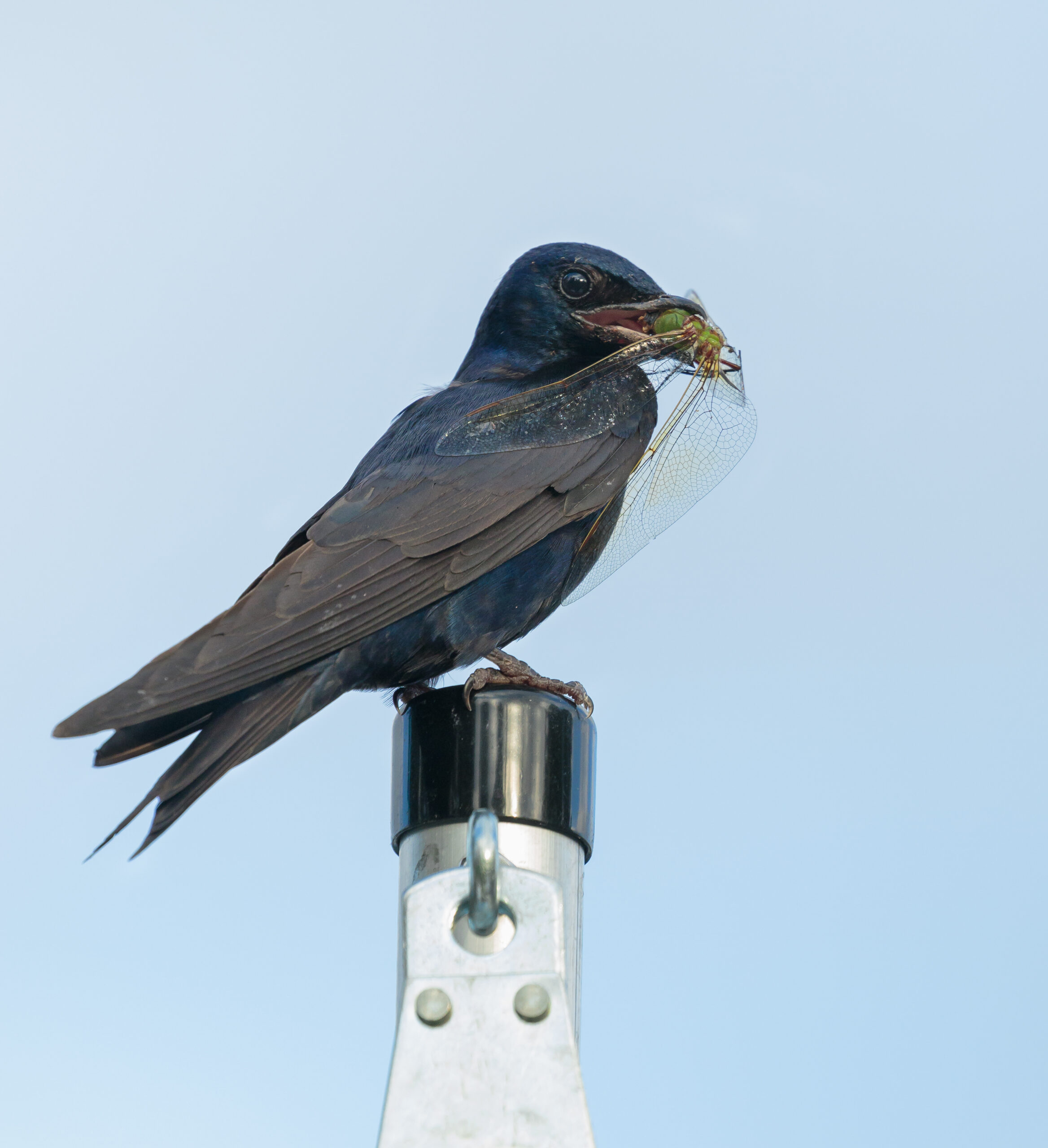Many Purple Martin landlords across the country are interested in maximizing their fledge rates for chicks at their colonies. It is possible to attract these backyard friends without getting into the deeper aspects of related citizen science, but for those who’d like to take on a more hands-on approach, the following information might prove helpful.
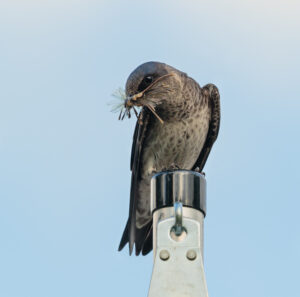
Adult female Purple Martin. Photo by Karen Brown
Along with controlling predators by installing effective pole guards, hawk/owl guards, and starling-resistant entry holes, monitoring nest cavities can boost fledge rates from an average of 50 – 90% or better. However, nest cavity management requires knowing the ages of chicks inside when lowering a gourd rack or house. Chicks disturbed when older than 21 days are at risk of fledging early and almost certainly will perish as a result — and the tricky part is that not all chicks in a housing system are the same age. As a result, keeping track of individual progress requires numbering each nest cavity. One basic landlord activity for increased fledge rate (and at times entire colony preservation) is the eradication of invasive, nonnative House Sparrows (HOSP) and European Starlings (EUST). These birds are persistent, and, to secure a nesting cavity, they will destroy eggs and even kill adult martins and their chicks. While starling-resistant entry holes are available to control EUST, HOSP must be actively controlled, most effectively by trapping and eradicating them, or at the very least continually destroying the nests they build in martin cavities. Invasive species control is critical because Purple Martins produce only one clutch a year compared to HOSP with up to four and EUST with two or more.
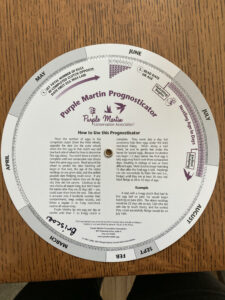
The Purple Martin prognosticator tool allows those monitoring nests to estimate hatch dates and when fledging will occur.
From the time the birds first arrive in the spring, active landlords check on the welfare of their invited guests and monitor nest building. The preferable time of day for nest cavity inspection is early afternoon when PUMA are generally out feeding and, later in the season, after females have laid their egg for the day, which always occurs in the morning. And once a first egg is laid, it’s time to chart the content of each cavity a minimum of every five to seven days. From this data, the easiest way to determine the hatch date is by using a prognosticator tool available through Purple Martin Conservation Association (PMCA). That tool also clearly shows when the chicks are vulnerable to early fledging and also shows the fledge date range, which is 26-31 days.
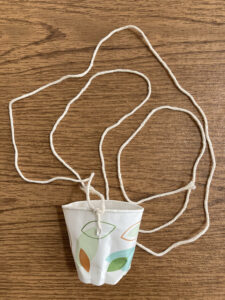
A small cup with a string attached works well for plugging nest cavity holes while performing nest checks.
Once a nest cavity has chicks that are 21 days old, landlords should not lower the house or gourd rack to check nests without plugging the entry holes of those 21-day-old chicks. It is imperative NOT to disturb that nest in any way. To plug those cavities, you can use small, squished, paper cups with long strings attached (or an old sock or small rag on a string) to block the holes of older chicks. Then and only then is it safe to check younger chicks in other nests.
Remember to act quickly while performing nest checks. Once completed, the rack is raised most or all the way up, and after about 10 minutes, when all the chicks are quiet, a gentle tug should safely remove the plug. The parents, that might be flying above or perching on the top of the housing watchfully, will return relatively unphased to the nest and begin feeding chicks again. I often see a parent with a dragonfly in the mouth waiting patiently on the top perch. PMCA has a very nice data-gathering form that can be downloaded and used to keep records, and at the end of the season, for scientific study, they would like your information — from nest building through fledging.
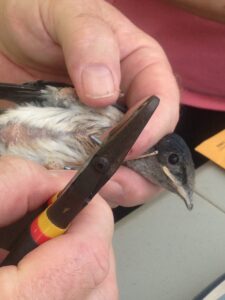
A Purple Martin chick from Briscoe’s colony is examined during the banding process.
Many landlords also perform nest changes because these chicks are in the nest for nearly a month, longer than almost all other songbirds, because they need to be able to fly upon fledging. Nests often can become wet and/or infested with deadly mites, blowflies, and other pests. It is not difficult, but unless an emergency, I wait until chicks have begun to develop their feathers and before the age of 21 days. Chicks can be removed carefully, one nest at a time, and placed one by one into a deep bucket on a bed of pine needles or other soft bedding, with a towel placed over the top. Old nests are removed, and the cavity wiped clean and dry. New nesting material is added, such as a small handful of cedar shavings at the bottom topped with dry, soft, white-pine needles and, finally, fresh green leaves. Chicks are then returned one-by-one to the refreshed cavity after a brief inspection and any needed removal of blowflies and other parasites. The parents will not abandon their chicks even if the nest you removed is considerably different from the new nest you provide. Over the years, I have seen mud dams, seaweed-built nests, woven straw and sticks, and more. If you are very careful that each family’s chicks are put back into the appropriate nest cavity, and the nest cavity is in the exact position that it was in before the nest change, you will save lives by changing nests.
I have also rescued chicks from the water and ground, which parent birds will not do. It is easy if you put the chick back into its nest or even in a nest with nearly equivalent-sized chicks, as long as you don’t overcrowd a nest. I have also built a shelter box on one of the high-up feeding trays by making an A-frame roof out of foam board and masking tape and placing older fallen chicks that likely failed their first flight attempt on it. The parents will return to feed them and nudge them to try again.
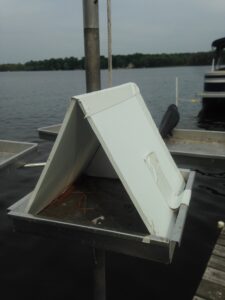
A supplemental feeding tray helps when weather affects the ability of Purple Martins to feed on insects.
Another reasonably easy assist Purple Martin hosts can provide is feeding during bad weather when flying insects — their only food source — is unavailable. This can occur throughout the nesting season when the temperature is below 50 degrees, or it’s very windy, dry, or rainy for two or more consecutive days. Providing a tray feeder up high near the nest cavities is one way to offer live mealworms, thawed fresh-frozen crickets, or even scrambled eggs with no additives. A tray feeder on a pulley system can be purchased online from Purple Martin Conservation Association. You can also place food in or on the housing or gourd. I like the separate tray feeder system because I don’t disturb the birds by lowering the housing rack. However, the birds must be inspired to eat from a stationary surface, and it takes patience. Some people have luck throwing such food in the air or using a plastic spoon or slingshot to encourage birds to fly and catch it. But other than providing entertainment value for my neighbors, I have never had this kind of success. Purple Martins will only eat the provided food if they are very hungry, so waiting until the second bad weather day is a good strategy. In addition, throughout the season, many people offer crushed eggshells that have been sanitized by properly heating them (baked at 200 degrees for 15 minutes).
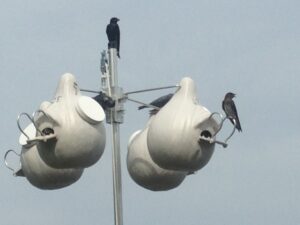
Purple Martin colony at Penny and Rick Briscoe’s property.
Our Southwest Michigan colony has been active for 35 consecutive years, but it has become more challenging to be successful due to various environmental factors. We began truly managing our colony in 2010 due to a near-disastrous season of cold and rainy July weather. But whatever the decision about the extent to assist your Purple Martins, the most important is simply to provide appropriate nest cavities in a proper location. These birds have somehow evolved to nest only in human-provided housing east of the Rockies, and they depend entirely on these nesting places for their very survival. And in return, the effort brings unlimited joy.
~ by Penny Briscoe
Purple Martin landlord and Michigan Audubon volunteer
Featured photo: Adult male Purple Martin by Karen Brown
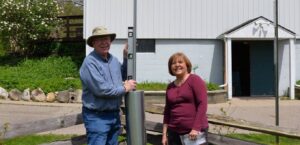 Penny Briscoe and her husband, Rick, are long-time Purple Martin landlords and would be happy to provide any needed assistance. They can be reached through the Facebook group “Michigan Purple Martin Friends,” Facebook Messenger, or Purple Martin Conservation Association’s martin mentor program.
Penny Briscoe and her husband, Rick, are long-time Purple Martin landlords and would be happy to provide any needed assistance. They can be reached through the Facebook group “Michigan Purple Martin Friends,” Facebook Messenger, or Purple Martin Conservation Association’s martin mentor program.
You can also read more about the Briscoes in Community Spotlight: Rick and Penny Briscoe, an article published in the 2021 spring issue of the Jack Pine Warbler.

